
Oceti Sakowin camp near
Standing Rock Reservation

World Wheel Newsletter
Global Peace Through the Arts
Spirit of Standing Rock
A Model for Our Lives and World
November, 2016
Global Peace Through the Arts
Spirit of Standing Rock
A Model for Our Lives and World
November, 2016
Vijali
Hamilton, MFA
View/Download Newsletter as PDF File
About this video: My time in Standing Rock, North Dakota at the Oceti Sakowin camp was one of the most inspiring times of my life. I felt I was experiencing what the Lakota Nation was like before they were invaded by the Europeans.. Everything was done in prayer and ceremony. All were honored and accepted no matter what race or color or gender. Perhaps Black Elk's vision of all hoops coming together as one world hoop is manifesting now. This is just a small taste of a film I am making that will be out soon, "Spirit of Standing Rock."
View/Download Newsletter as PDF File
Beloved World Family,
I
drove two days from Santa Fe, New Mexico to the Oceti
Shakowin camp near the Standing Rock Reservation in
North Dakota and am filled with inspiration for what
is possible at this time on our planet. Perhaps I had
a glimpse of what life was like among the Lakota
(Sioux), and other original peoples in North America
before the European invasion and their colonization.
The effort to protect the Lakota way of life and our shared waters: “Water is Life” being the common refrain by the NO DAPL (“NO Dakota Access Pipe Line”) protesters, has brought over 200 Indian nations together at the Standing Rock camps. People of all nationalities, red, white, yellow and black have arrived from the four quarters of the world to join the Lakotas in their effort to protect their sacred sites and waters, not as protesters, but as Water Protectors. It has awakened the common cord that links the hearts in many contemporary social and environmental movements.
The effort to protect the Lakota way of life and our shared waters: “Water is Life” being the common refrain by the NO DAPL (“NO Dakota Access Pipe Line”) protesters, has brought over 200 Indian nations together at the Standing Rock camps. People of all nationalities, red, white, yellow and black have arrived from the four quarters of the world to join the Lakotas in their effort to protect their sacred sites and waters, not as protesters, but as Water Protectors. It has awakened the common cord that links the hearts in many contemporary social and environmental movements.
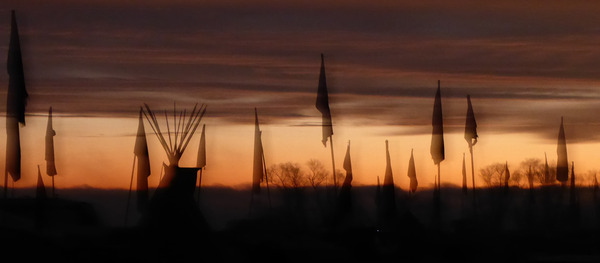
Evening at Oceti Sakowin camp
I
arrived late at night thinking that the late hour
might be an inconvenience for the people of the camp,
but was greeted with great warmth by a young Lakota
man at the entrance to the main camp. Ocheti Shakowin
is situated not far from the location where DAPL is
poised to sink their pipeline, carrying the dirtiest
of fracked crude oil under the Missouri River, which
serves millions of people with clean water. The Lakota
people remember a prophecy that was handed down
through generations regarding a giant black snake that
would slither across their lands and threaten Mother
Earth. They feel certain that this pipeline is that
endangering black snake. For there is always that
possibility that the pipeline could break, destroying
life in the environment and making the water
undrinkable.
Driving into camp I found a space to park between tents and tipis angled so as not to look directly into the glaring spot lights that DAPL had installed on the hillside in order to separate us from their work at the river. It reminded me of prison lights for readily spotting a truant inmate. Crawling into my double sleeping bags laid out in the back of my car, it didn’t take me long to be cradled asleep by the aromas of burning sage and cedar, and the cooking woodsmoke from the many campfires.
The next morning I awoke at 5 AM by Lakota morning chants for greeting the sun and imbuing the day with its sacredness. Within the hour a large crowd had gathered around the sacred fire with more chanting and prayers for all people, yes, even for the police and the men working bulldozers. A Lakota man in his sixties, announcing himself not to be an elder but a pipe carrier from the age of 27 drew the men closer to the sacred fire for the pipe ceremony while women gathered for their water ceremony at the river.
Driving into camp I found a space to park between tents and tipis angled so as not to look directly into the glaring spot lights that DAPL had installed on the hillside in order to separate us from their work at the river. It reminded me of prison lights for readily spotting a truant inmate. Crawling into my double sleeping bags laid out in the back of my car, it didn’t take me long to be cradled asleep by the aromas of burning sage and cedar, and the cooking woodsmoke from the many campfires.
The next morning I awoke at 5 AM by Lakota morning chants for greeting the sun and imbuing the day with its sacredness. Within the hour a large crowd had gathered around the sacred fire with more chanting and prayers for all people, yes, even for the police and the men working bulldozers. A Lakota man in his sixties, announcing himself not to be an elder but a pipe carrier from the age of 27 drew the men closer to the sacred fire for the pipe ceremony while women gathered for their water ceremony at the river.
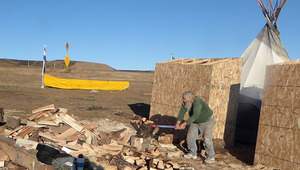
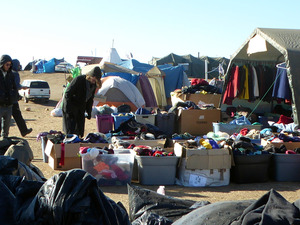
Chopping wood for cooking and sacred fire Warm clothes donations
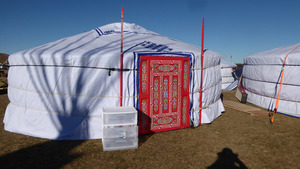
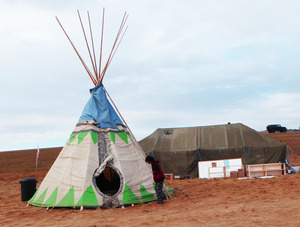
Mongolian yurt for healing Tipi school for children 8 to 14 years old
The
morning was filled with wood chopping, cooking,
erecting many Mongolian yurts and the building of
permanent simple structures for the large number of
people who planned to live through the very cold
winter by way of a permanent life style. I brought
along donations provided by Santa Fe friends
consisting of warm clothes and a container of food for
the main volunteer kitchen. Art supplies which I had
also brought, I later took to the children’s school
being held in a tipi and gave money (again through
donations) for the legal group, media program, food,
building supplies, and medical supplies - all provided
to a designated representative in a tent behind the
gathering circle and sacred fire.
At noon I visiting with Winona, a large Lakota mama who loves to cook for people, and gave her a large basket of potatoes zucchinis and carrots. Afterwards I had a delicious traditional meal of bison/cabbage soup and frybread.
At noon I visiting with Winona, a large Lakota mama who loves to cook for people, and gave her a large basket of potatoes zucchinis and carrots. Afterwards I had a delicious traditional meal of bison/cabbage soup and frybread.
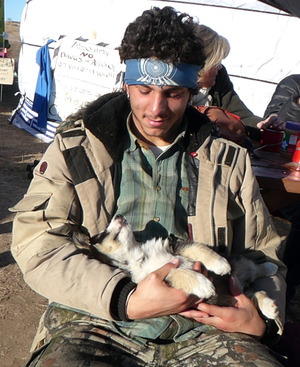

"Mother and Child" Vijali at camp Oceti Sakowin
In
the afternoon I climbed the so called “media hill”
rising above the camp to the west where a wind turbine
generates electricity for people to charge their
cellphones, and to also charge my video camera. I
found the media tent and went through the orientation
to receive a press pass that was to be worn at all
times. Although most media people represented a
network, I presented my NGO, World Wheel, Global
Peace Through the Arts credentials (which I
started in 1986) in order to create a documentary
film. My intention for the film is to show the
spiritual wisdom and dynamics underlying the movement
at the Standing Rock camps. Also, I wanted to explore
women’s roles and energies in this spiritual revival.
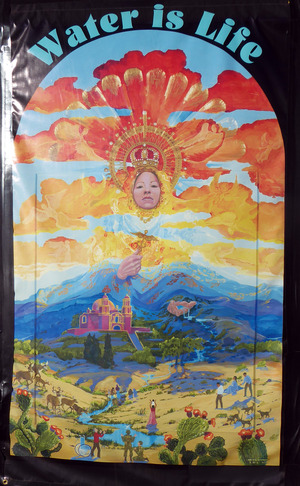
Water is Life poster on side of Van at camp
In
the afternoon of the next day I attended the
orientation for “peaceful direct action,” which
prepares one to join in as a “peaceful water
protector.” We were told how to attempt to protect
ourselves from mace and tear gas with glasses and
mask, and how to not ultimately resist the police and
drilling company security. But what was most
impressive for me was that these acts were fully
informed by ceremony and prayer. Prayer for the
police, prayer for the Army Corp of Engineers who
control Lakota land that was designated for them
through the 1851 treaty of Fort Laramie. Certainly
this movement is the Native American’s Gandhian salt
march for our times!
After this orientation I interviewed a young Cherokee girl, Olive who had been twice arrested and thrown into a wire dog kennel for hours without knowing the charges, and held until the next day. Then she was released by the wonderful group of lawyers who have raised money exactly for this purpose. She spoke with much passion, “Water is our own body, 75 percent, and is life itself which we must protect. I will let myself be put in jail as many times as it takes to stop this desecration of our Mother Earth.” As we talked I heard the loud buzz of a helicopter and we looked up as it circled overhead. She continued, “This is a daily occurrence. They come many times, day and night.”
To view Olive and have a glimpse of my film that will be out soon, Spirit of Standing Rock, click here: https://www.youtube.com/watch?v=8J3Lo6pjpi4
After this orientation I interviewed a young Cherokee girl, Olive who had been twice arrested and thrown into a wire dog kennel for hours without knowing the charges, and held until the next day. Then she was released by the wonderful group of lawyers who have raised money exactly for this purpose. She spoke with much passion, “Water is our own body, 75 percent, and is life itself which we must protect. I will let myself be put in jail as many times as it takes to stop this desecration of our Mother Earth.” As we talked I heard the loud buzz of a helicopter and we looked up as it circled overhead. She continued, “This is a daily occurrence. They come many times, day and night.”
To view Olive and have a glimpse of my film that will be out soon, Spirit of Standing Rock, click here: https://www.youtube.com/watch?v=8J3Lo6pjpi4


Camp Oceti Sakowin Apolousa horse of Lakota boy
Signs
were everywhere: “No drugs or alcohol, no guns or
weapons” and “This is a camp of prayer, ceremony and
healing.” From morning to late at night a loudspeaker
rang out sacred songs and welcoming wishes to new
guests as more and more people arrived. I heard the
count was now up to 2,000 people camping at the Oceti
Sakowin camp alone and all were working together in
ceremony and in the most beautiful harmony. One woman
had her radiator damaged by a deer. Immediately a call
went out on the loudspeaker for a mechanic to come and
help her.
In the afternoons and evenings there were Inipi (Sweat Lodge) ceremonies being conducted; some for women, some for two-spirit people, some for men. All people were honored no matter their color of skin, sexual orientation or gender; everyone was friendly, ready to smile or answer questions, or simply get to know you.
In the afternoons and evenings there were Inipi (Sweat Lodge) ceremonies being conducted; some for women, some for two-spirit people, some for men. All people were honored no matter their color of skin, sexual orientation or gender; everyone was friendly, ready to smile or answer questions, or simply get to know you.

Rosebud Camp on Standing Rock
Reservation along the Cannon Ball River at dusk
I
felt so happy at the camp and saw the joy on the faces
of everyone, especially the young people. A joy
knowing that divinity is not just in the Creator, but
also in the sky, within every person, every tree,
every animal, every stone and in water herself. A joy
with a purpose, creating community and a new kind of
family—something that our materialistic society does
not offer our young people.
The next morning at our collective breakfast gathering there was a rumble through the crowd with news that 500 National Guard troops would descend on the camp in December, and that the Lakota Elders were going to send all women and children out of the camp. Is this all a voice from the past, when the Ghost Dance was held on Lakota land, drawing together the original peoples in a spiritual revival of hope after the brutal years of reservation life? Was and is this the ghost dance that panicked the government on seeing its massive gathering which in 1890 prompted the Seventh Cavalry, Custer’s reconstructed regiment, to massacre almost every single person, even babes still nursing at the breast of their dead mother as the snow covered them and froze them both in her own blood?
News went out through the camp that President Obama and the Army Corp of Engineers have placed a hold on the pipeline construction stopping the work, at least for now, to research its environmental empact, and hope against hope, to find an alternate route. But here at the camp we know that these are just words, amid the on going work we still hear rising over the hill.
The next morning at our collective breakfast gathering there was a rumble through the crowd with news that 500 National Guard troops would descend on the camp in December, and that the Lakota Elders were going to send all women and children out of the camp. Is this all a voice from the past, when the Ghost Dance was held on Lakota land, drawing together the original peoples in a spiritual revival of hope after the brutal years of reservation life? Was and is this the ghost dance that panicked the government on seeing its massive gathering which in 1890 prompted the Seventh Cavalry, Custer’s reconstructed regiment, to massacre almost every single person, even babes still nursing at the breast of their dead mother as the snow covered them and froze them both in her own blood?
News went out through the camp that President Obama and the Army Corp of Engineers have placed a hold on the pipeline construction stopping the work, at least for now, to research its environmental empact, and hope against hope, to find an alternate route. But here at the camp we know that these are just words, amid the on going work we still hear rising over the hill.
I
remember years ago being taken by the 103 year old
Hopi sage, Grandfather David Monongye to their
“Prophecy Rock.” He explained to me, running his aged
finger along a weathered line carved into the
sandstone boulder leading to a fork in the carving:
“here is where we have a choice, a choice to either
completely destroy ourselves or to effect the renewal
of our way of life.” Could today’s many crises be
bringing us to that fork in the road of life, that
moment and choice between death or the renewal of
life?
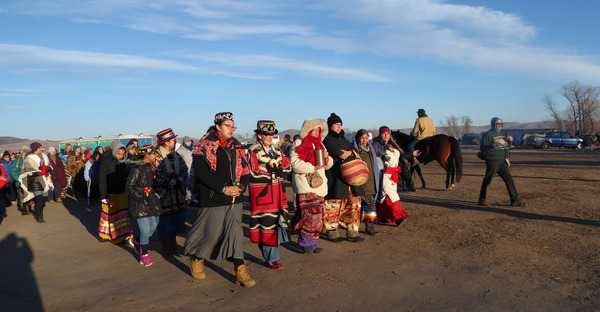
Indigeno women leading us to the river for their water ceremony
Each
day a new group of people would arrive. One day it was
a group of indigenous peoples from Alaska represented
by women. They entered our circle at the sacred fire
singing and presented the camp a gift of a banner that
the women had created. Each woman spoke to us in their
native languages about women as water and the
importance of water on our Mother Earth and in our
lives. An eagle circled above us, certainly a blessing
from our winged relatives. They led us to the river
for a water ceremony where each of us made a prayer to
the river with tobacco and cedar offerings and to
deposit sacred water which they carried with them from
their sacred rivers and which we each were blessed to
drink.
On
another day, indigenous women arrived from
Saskatchewan, Canada, and again sang and spoke in
their native languages. In the evening an aboriginal
man from Australia danced his people’s traditional
dance around our sacred fire. The next day was
Veteran’s Day and 700 veterans arrived and we held a
ceremony together. Another day elders from many Native
American communities arrived and spoke of the meaning
for all indigenous peoples of working together, of
their own problems such as deforestation of their
lands, mining and oil exploitation, and of letting go
of their past differences in order to come together in
unity.

Black Elk
As I
witnessed these happening, I remembered reading in the
classic Lakota book Black Elk Speaks of the
great sadness that this Oglala Sioux holy man, Black
Elk had carried into his old age regarding his great
vision (which came to him when he was only nine years
of age) and which had not come to pass:
And
I, to whom so great a vision was given in my
youth,—you see me now a pitiful old man
who has done nothing, for the nation’s hoop is
broken and scattered. There is no
center any longer, and the sacred
tree is dead.Here at the camp, as this gathering grows larger and larger many Lakotas feel that Black Elk’s vision is now coming to pass. It was much like Black Elk had spoken, regarding a renewed and harmonious hoop of the world in which many hoops of peoples would come together as one:
Then
I was standing on the highest mountain of them all,
and round about
beneath
me was
the whole hoop of the world. And while I stood there
I saw more than I can tell and I
understood more than I saw; for I was seeing in a
sacred manner the shapes of all things in
the spirit, and the shape of all shapes as they must
live together like one being. And I saw
that the sacred hoop of my people was one of many
hoops that made one circle, wide as
daylight and as starlight, and in the center grew
one mighty flowering tree to shelter all
the children of one mother and one father. And I
saw that it was holy.
After
a week’s stay I drove out of the camp through the main
dirt road as lovely appaloosa horses ridden by Lakota
boys from the Standing Rock Reservation galloped past
me. The road was lined with hundreds and hundreds of
flags from all over the world representing many
indigenous nations, and organizations of healing and
sustainability.
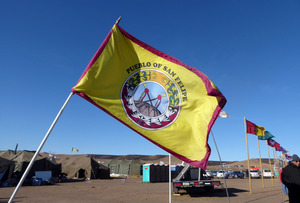

Flag of San Felipe Pueblo Main road into Oceti Sakowin camp
As I
started the two and a half days’ drive back to New
Mexico, my body was filled with spirit and my heart
with joy, beauty and hope for the future of the
Standing Rock Lakota camps as a model community for
all beings on Mother Earth.
Peace and Blessings,

P.S.
To make donations for the Water is Life movement, go to: SacredStoneCamp.org
Vijali
Hamilton, MFA
www.worldwheel.org
vijali@worldwheel.org
cell: 202 492 4899
YouTube Channel: Vijali’s World Wheel
all photos and videos by Vijali Hamilton (except Black Elk)
vijali@worldwheel.org
cell: 202 492 4899
YouTube Channel: Vijali’s World Wheel
all photos and videos by Vijali Hamilton (except Black Elk)